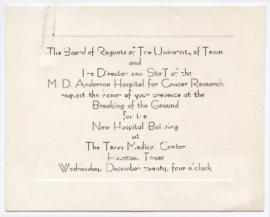This 1” open-reel video tape opens with a graphic announcing the “Houston Academy of Medicine Texas Medical Center Library” The production highlights the history, purpose, value, and future of the Library. While the recording lasts 7:12, the actual content runs about 5:30.
Narration is by Ron Stone. The video was made possible by a gift from the Friends of the Texas Medical Center Library. It is a production of UT Television, the University of Texas M. D. Anderson Cancer Center, 1997.
The recording starts with color bars and test sound, followed by a blank screen. Content begins at 1:43.
(1:43) The video opens with historical images from the TMC Library, as the voiceover notes it “has never hesitated to meet the challenge of the future.”
(2:18) The video cuts to the present day, featuring images of students studying, including at computers. The narrator reiterates the Library’s purpose “to make knowledge accessible to the entire community.” The TMC Library’s new five-year plan is introduced.
(2:34) Naomi C. Broering, MLS, MA, Executive Director, HAM-TMC Library. She cites the support of the Houston Endowment and the M. D. Anderson Foundation. She highlights the plan to develop a Health Informatics Education Center, Consumer Health Information Service Area, Knowledge Management Center, and Conferences in Computers in Health Care. She cites the TMC Library’s involvement in telemedicine, teleconferencing, and remote distance learning.
(3:25) Damon Camille, Public Affairs Services, HAM-TMC Library. He stresses the importance of supporting library users in the places where they work and study. As the video shows images of students and faculty using computers, he talks about teaching people to access information online via the TMC Library.
(3:53) Larry S. Jefferson, MD, Baylor College of Medicine, Texas Children’s Hospital. He testifies to the value of electronic access to MedLine, which he says is used on a daily basis. As he speaks, the video shows images of children and physicians in the hospital.
(4:25) Barbara Skjonsby, RN, BSN, Baylor College of Medicine, Texas Children’s Hospital. The video shows images of children and caregivers in the hospital, while she highlights the TMC Library for access to medical studies that benefit patients.
(5:05) Randall Sharer, University of Texas-Houston Medical School. He highlights access to resources across schools and programs, saying the TMC Library Addresses everyone’s needs. The video shows images of students and/or colleagues studying.
(5:30) The video cuts to an exterior view of TMC Library and highlights its role as one of National Library of Medicine’s eight Regional Medical Libraries. It shows the MedLine website to highlight online access.
(5:50) The McGovern Historical Collections and Research Center is featured.
(6:08) The video cuts back to the TMC Library website. The narrator highlights the TMC Library’s ability to improve lives through the power of the IT infrastructure and the reach of the TMC Library’s information.
(6:35) Naomi C. Broering, MLS, MA, Executive Director, HAM-TMC Library. She highlights the Friends of the Library, the Library Board, foundations, institutions, and individuals who help support the Library. She praises their support for a program that will “build the library for the 21st century, the virtual library for the next millennium.”



